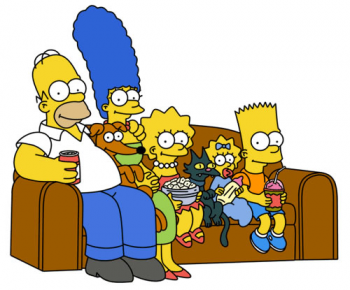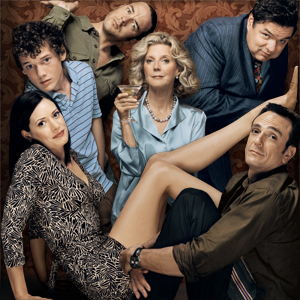Introducing Television

A brilliant literature professor at the University of British Columbia in Canada, William New, taught me that the first three pages of a good novel tend to encapsulate all the major themes of that novel, setting the tone and preparing the reader for the storyworld ahead. So too with television programs and their intro sequences.
Whether it’s The Who’s scream that kicks off CSI: Miami with a bang, the ultra hip Sopranos theme playing as we see the Lincoln Tunnel through Tony’s eyes, the Where in the World is Carmen San Diego? meets Mission Impossible opening of The Amazing Race, or any other number of intro sequences, these short little visual poems are frequently masterfully created. Most intro sequences must, after all, establish the narrative world into which we are entering; they must introduce us to the cast, frequently explaining their interrelationships; and their music and images establish the cyclical nature of the televisual product, reassuring us with their familiarity. Indeed, it is one of the great tricks of Lost that there is no intro sequence, and no theme song, just a cheaply done Microsoft Word Text Art title, as creators Abrams and Lindelof seem to taunt the viewer with their unwillingness to give us answers, to genre, plot, or character.
Consider Showtime’s Huff: a rather odd piece of music plays in the background, swaying back and forth, just as the camera itself moves erratically amongst many framed boxes, each containing action or stills from main character Huff’s life. Occasionally, the music samples a snippet of decontextualized dialogue — “You are so beautiful,” or “You’re supposed to be thinking about what I’m feeling here,” for instance. Main characters can be caught sight of in the boxes, but only briefly. It is hard to explain in words, but the sequence powerfully communicates that we are in the character’s mind — scenes move at different speeds, and we are clearly seeing everything through the individual perspective. Its surreal quality also invites interpretation and analysis, much as a patient in therapy might, as the show implores us to piece together all these random elements. In effect, the sequence maps out the mind and its many odd interconnected thoughts, hence setting the tone for a program about the mind, sanity, and wellness. Meanwhile, the music gently lulls viewers into the program’s own frame, transporting us from the world around the television set to the world inside it.

Gerard Genette wrote of paratexts as serving an “airlock” function, acclimatizing readers to the world of the text, and the intro sequence is the paratext par excellence for acclimatization. We might even wonder if the networks’ fairly recent move towards delaying the intro sequence is more about teasing the viewer by withholding the beloved “airlock” than it is about opening in media res. Of course, channel-surfers often miss the sequence, but for a program’s regular viewers, there is a ritual of viewing, and the intro has come to play a large role in that ritual, not just an airlock therefore, but akin to saying grace before dinner, singing the anthem before a sports game, or playing music before the bride enters the wedding chapel. And as with these last two examples, the music is often a central part of the ritual, the ultimate in familiarity that immediately connects the moment across time and space to the last time we heard and saw the sequence, enacting (dare I say, lest this paragraph collapse under the weight of too many metaphors) a homecoming, or what Will Brooker, following Roger Aden, might call a step in a symbolic pilgrimage.
But ritual isn’t just about familiarity: ritual controls action. Therefore, intro sequences also represent a frequently impressive attempt by producers to situate and contextualize their text before delivering it. The intro sequence aims to discipline the audience’s viewing, and it poses “proper,” “official” meanings and structures of viewing. Thus, for instance, we could examine the intro sequences of three shows with large casts, to see how they manage the density of characterization and relationship in play:
1) ER gives fleeting attention to its cast, only for credit purposes, instead painting them all as generic doctors, with the ever-present heartbeat-like music in the background. The sequence suggests the primacy of the setting — a hospital — and of the work — saving lives — snd hence already cues us in to the revolving door of cast members that has characterized the show.
2) Buffy the Vampire Slayer, by contrast, wins the Most Shots Per Minute prize, offering a cruise ship buffet of character-establishing shots for each cast member (shots that changed from season to season, no less), to rapid and excited guitar music. By the end of its forty-five second-or-so run, the sequence has laid out a considerable map of who is related to whom, and how, announcing that the show is not only about butt-kicking, but also quintessentially about relationships.

3) Finally, The Simpsons’ intro sequence privileges the family in its little School/Work’s Over vignette, but plasters the streets of Springfield with many other characters, quickly sailing by Bart’s skateboard or the parents’ cars; this, and the changing blackboard lines and couch gags from week to week tell us from early on that this is a show centered on a post-work, post-obligation family, but also a show that will reward attention: the beauty will be in the details, and in the background’s fine print.
Intro sequences might seem peripheral, but popularly, they are at the center of many networks of nostalgia and cultural memory. Witness, for instance, how half of New York City, so it seems, has a Sex and the City ringtone; or just try whistling one bar of The Andy Griffith Show without someone recognizing it immediately (yes, even teenagers). Derek Kompare’s impressive book, Rerun Nation, examines American television’s and American viewers’ love affair with reruns, but many of us don’t even need the visuals to renew the romance: a simple riff or two of the theme song is clearly enough to stand in for the whole. And with the theme song only part of the intro sequence, what we have is a synecdoche of a synecdoche of a program. But a synecdoche of considerable power, therefore. The intro sequence offers a primer to a program, but then takes on its secondary and lasting role as ritual gatekeeper and greeter, not only to the narrative and characters within, but to the entire narrative universe.
References
Aden, R. (1999) Popular Stories and Promised Lands, Alabama: University of Alabama Press.
Brooker, W. (forthcoming) “A Sort of Homecoming: Fan Viewing and Symbolic Pilgrimage,” in J. Gray, C. Sandvoss, & C. L. Harrington (eds), Fan Audiences, New York: NYU Press.
Genette, G. (1997) Paratexts, Cambridge: Cambridge University Press.
Kompare, D. (2004) Rerun Nation, New York: Rotuledge.
Image Credits:
1. The Simpsons
2. Cast of Huff
3. Bart Simpson
Please feel free to comment.
An argument can also be made that these introductions can somewhat being misleading in certain senses. For example to what extent “Sex in the City” or “Seinfeld” contribute to propagate the myth of Manhattan as a “white only” island or “cops” the mythology of the police state.
Changes in intro sequences
I’ve always thought that credit sequences are more deserving of scholarly attention than they get, so thanks, Jonathan for attending to them. I’m wondering how we might think about these pieces of television texts historically. I remember a time (late ’80s/early ’90s?) when introductory sequences became passé (perhaps the theme song was too disturbingly reminiscent of the cheesy ’70s). How and why did the taste tides turn away from this device and then toward it again?
It’s also an interesting question when considering U.S. daytime soaps. For many years, the introduction to General Hospital featured an amublance, siren wailing, and a brief bit of music. Sometime during the 1990s, however, the show began to offer a longer introductory credit sequence, with updated music and a series of images of the show’s large contract cast. That sequence has changed over the years but still features the impossibly beautiful faces of the actors. I’ve always had the feeling that the actors are posing as themselves, not as their characters, in these sequences, probably because they look directly into the camera, breaking the fourth wall that is never, ever, broken in soap-land. Unlike those of prime-time shows, these sequences tell you very little about the characters. They do point out some character relationships (based on the order in which actors appear), but the relationship dynamics change so frequently that the producers wisely refrain from including any clinches between couples or other such identifiers that would mark the sequence in a specific story time.
Tonal orientation
Kudos to Jonathan for raising the formal and (dare I say) aesthetic dimensions of TV credit sequences so engagingly. Just to add, another key function of openings is to orient viewers to the program’s tone, pulling us out of our flow and into a particular aesthetic. For instance, I find the opening to Six Feet Under particularly effective at pulling me into the meditative pace and attitude of the series, while an open like The Simpsons establishes the show’s frantic tone more than characters. And I always love watching my students squirm during the interminable credits for Twin Peaks when I screen it in class – the virtually unmoving shots of trees, water, and the lumber mill (and the narcoleptic theme music) perfectly set the stage for the uncanny oddness that will follow.
TV on DVD means 22 credit sequences…
This conversation is off to a good start, but let’s not forget that a growing number of viewers watch at least some programs on DVD (through video store rentals or services like Netflix). In these circumstances, the intro/credit sequence can work in significantly different ways.
First off, for me they can often simply be a nuisance. The past two summers, my wife and I have stocked our Netflix queue with Sopranos, Six Feet Under, and other shows we don’t watch during the school year, and once that first episode is done, we’re ready to start the next one right then. Who wants to watch the same intro you just saw 43 minutes ago? In some cases, the DVDs are chaptered so you can simply skip them, but not always. When I’m hankering for the next ep, I really have not interest in the opening sequence.
By extension, I would imagine I’m less likely to recognize the cultural cues–like a snippet of a theme song appropriated in an ad or on a fan web site–as well as weekly viewers. Does this make me less of a fan of these shows, or just a different kind of consumer? And am I less oriented to the series’ tone when I skip the intro? Have I fundamentally missed as aspect of the aesthetic experience of the series?
This is important in light of the variety of ways viewing practices are changing with widespread acceptance of digital technologies. A growing (though still small) percentage of viewers don’t even consume TV in anything like the kind of flow Williams wrote about. (Jason Mittell and others have written about some of these practices on this site.) Or, if we want to keep using the term but more broadly to refer to a “cultural flow”, of which television viewing is one of many aspects of media consumption, then the issue remains: what can be said about the experience of viewing without the orienting properties of the opening sequence (whether by choice or accident)?
A waste of time?
In many cases, opening credit sequences provide essential backstory. This is especially the case with sitcoms, where narrative is so compact that credit sequences are really the only way for us to grasp how these quirky characters came to be involved in their quirky (well, maybe …) circumstances. Hourlong shows tend to interweave more backstory into their narratives. It’s an interesting phenomenon in syndication that the credit sequences are a major target for cutting when time needs to be made available for more commercials. Perhaps this suggests a truism: that most poeple who watch stripped sitcoms are watching more for comforting familiarity (already knowing the backstory) than for new information?
I didn’t get a chance to read this article last year when it was published, but now in the process of reviewing past issues and columns, I wish I had. For now I’ll just say thanks for talking about Huff, and even more so for helping me understand why it’s the only intro to a TV show that I watch…over and over. I usually watch a show’s intro once (or once per season if it changes, a la Buffy or The Wire) and then skip it. I’m just not interested! But I watched Huff‘s at least for the entire first season and a few times in the second. It’s complexity as well as its design invited me to decode it in a way that most shows do not, and I really appreciated the aesthetic approach the creators used.